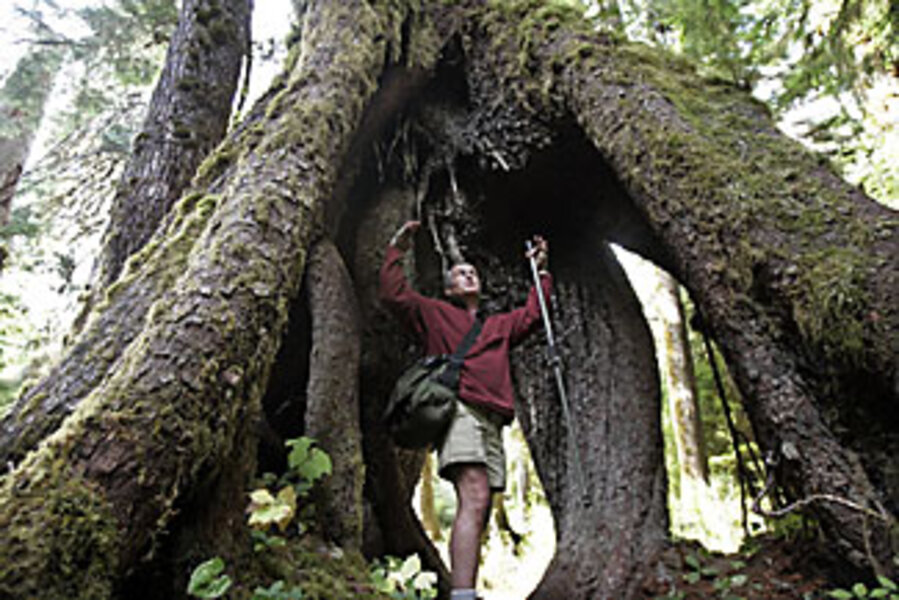Defender of quiet places
Loading...
I checked in with Gordon Hempton the other day. The adventurer answered his cellphone while shoveling gravel outside his Washington State home. I was fortunate. Mr. Hempton is frequently off in the wilderness, recording pristine sounds of the natural world. You may have heard his soundtracks of rain forests dripping, surf crashing, streams burbling, frogs croaking, birds trilling, and so on. The self-described "sound tracker" is an activist in defense of Earth's ambience, which Hempton says is disappearing faster than it can be preserved. Why? We simply make too much noise.
"Quiet is going extinct," laments the acoustic ecologist, a fancy title for an expert on the environment of sound. In the background, I hear the grating of stones against metal.
I wonder about unwanted racket in the West. Even where I live, in small-town New Mexico, things seem noisier than they did only a decade ago. "Have you followed up on your 1998 survey?" I ask.
The shoveling stops.
"Nah," Hempton replies, an edge of disappointment in his mellifluous voice. "Conditions were bad everywhere I went, including parks and wilderness areas. I knew I would never make that trip again."
Ten years ago, the man with the ultra-sensitive microphone toured 15 states. "I looped from the Pacific Northwest down to Arizona," Hempton recalls, "then through the Rockies and into the northern Midwest." During daylight only two locations – remote parts of Colorado and Minnesota – were reliably free of such distractions as car engines, jet planes, chain saws, and gunfire. Even Yellowstone National Park and the Grand Canyon suffered from the whine of machinery, whump-whump of helicopters, and drone of distant traffic. Taping a quarter-hour of undisturbed natural ambience was almost impossible.
"It was so much work to get 40 or 50 hours of usable material in places where I once recorded 200 to 300 hours," Hempton says with a sigh.
What changed? Until the 1980s, most invasive sounds in the backcountry came from single, stationary sources. "I could wait for a while and the interference would stop," Hempton explains. "Now I'm likely to hear two or three or four periodic, intrusive noises."
The din accumulates from cows, dogs, all-terrain vehicles, portable stereos, trucks – you name it. Even mountain bikers pose a problem: "They tend to chat with one another even when they are 50 yards apart." And the hum of electric transmission cables and natural gas lines can travel long distances. "I can hear it," the recordist declares, "and my hearing is not significantly better than that of the average person."
A discouraged Hempton has almost given up recording outdoors in the Lower 48, preferring remote destinations elsewhere. In the hope of protecting them, he declines to pinpoint locales. In 2005, he declared himself the defender of "one square inch of silence" in nearby Olympic National Park, reasoning that a space of silence could have as large an impact as the noise of a passing plane. (A book by Hempton of the same name is being published in March.)
"Where are places entirely free of human-created sound?" he asks. "There really aren't any – not for 24 hours a day, seven days a week. They're all gone. Even the North Pole is under airplane flight paths." Hempton estimates that only one-tenth of 1 percent of Earth's land surface still offers complete quiet for periods longer than 15 minutes.
"Wherever there are lots of people, there's a lot of noise," he says. "Some cultures are louder than others. For instance, I've visited a few developing nations where the only acceptable volume on a boom box is all the way up."
Our conversation confirms my conclusion that the mechanical clamor of the Industrial Revolution and the electronic beep of the Information Age are conspiring to obliterate a balm of stillness that once soothed humankind. That's a tragic loss, in my estimation, because retreats into nature allowed our ancestors to maintain their equilibrium. I'm convinced that a walk in the woods or through a meadow helped keep them sane. This is where they developed the resilience to handle whatever personal challenge or crisis was at hand. Scientific studies confirm the capacity of "quiet alone time" to reduce stress, expand insight, and promote a sense of well-being.
Restorative time in the open air is when many of us touch the fullness of possibility, waking up to the cause and effect of our lives. Escaping what one poet called "the world of the made" opens doors to the yearning heart, the wisdom of intuition, the miracle of problem solving, and the truth of experience. On hikes near my home I reconnect to some of my strongest passions, fondest wishes, and happiest memories. Such reveries allow us, as Henry David Thoreau reported from Walden Pond, to "be completely true to ourselves."
Yet according to a study published last February, Americans are becoming increasingly disconnected from nature. Since the late 1980s, the percentage of our population hiking, camping, or visiting national parks and forests has fallen 1 percent annually. One consequence may be decreased societal interest in conservation.
Experts blame the trend on lives too crammed with activity to get away from it all. But nature's quiet is a healthy antidote. If we embrace the stillness and serenity of our natural world, we may willingly release some of the busy behaviors that imprison us indoors. Gordon Hempton calls such getaways "the think tank of the soul." Here we may find that less really is more, that a simpler life can be a richer one, and that the calming sounds of planet Earth are worth saving.





